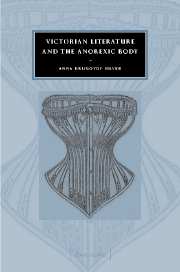Book contents
- Frontmatter
- Contents
- Acknowledgments
- Introduction
- 1 Waisted women: reading Victorian slenderness
- 2 Appetite in Victorian children's literature
- 3 Hunger and repression in Shirley and Villette
- 4 Vampirism and the anorexic paradigm
- 5 Christina Rossetti's sacred hunger
- Conclusion: the politics of thinness
- Notes
- Bibliography
- Index
- CAMBRIDGE STUDIES IN NINETEENTH-CENTURY LITERATURE AND CULTURE
5 - Christina Rossetti's sacred hunger
Published online by Cambridge University Press: 22 September 2009
- Frontmatter
- Contents
- Acknowledgments
- Introduction
- 1 Waisted women: reading Victorian slenderness
- 2 Appetite in Victorian children's literature
- 3 Hunger and repression in Shirley and Villette
- 4 Vampirism and the anorexic paradigm
- 5 Christina Rossetti's sacred hunger
- Conclusion: the politics of thinness
- Notes
- Bibliography
- Index
- CAMBRIDGE STUDIES IN NINETEENTH-CENTURY LITERATURE AND CULTURE
Summary
We must not look at goblin men,
We must not buy their fruits:
Who knows upon what soil they fed
Their hungry thirsty roots?
(“Goblin Market” lines 442–45)Representations of fasting and starvation in the texts that I have discussed so far are largely located in the secular realm. Though Brontë, for example, connects gluttony to Catholicism, Lucy's starvation in Dracula is never located within a religious paradigm, nor is little Nell's wasting away an explicitly religious undertaking. Religious fasting did, however, enjoy a revival in the nineteenth century, both as part of the Oxford Movement in the Church of England, and in dissenting churches. Spiritual fasting and “material” fasting share some clear commonalities: food restriction within a religious context, like anorexia nervosa, constitutes a means of mortifying the body, and it posits, as does anorexia, a fundamental conflict between the desires of the body and the soul. By denying the body's needs and wishes, fasting becomes a means of purifying and cleansing both body and soul. However, the woman fasting at Lent undertakes a different practice than the woman restricting her food intake in order to fit into a particular dress size; there is clearly a slippage between these two behaviors, despite their similarities. How, then, does one approach religious fasting and connect it, if at all, to secular fasting? The work of Christina Rossetti opens up a fruitful discussion of these questions, as images of feasts and fasts recur frequently in her work, almost exclusively within the context of religious faith.
- Type
- Chapter
- Information
- Victorian Literature and the Anorexic Body , pp. 136 - 170Publisher: Cambridge University PressPrint publication year: 2002



